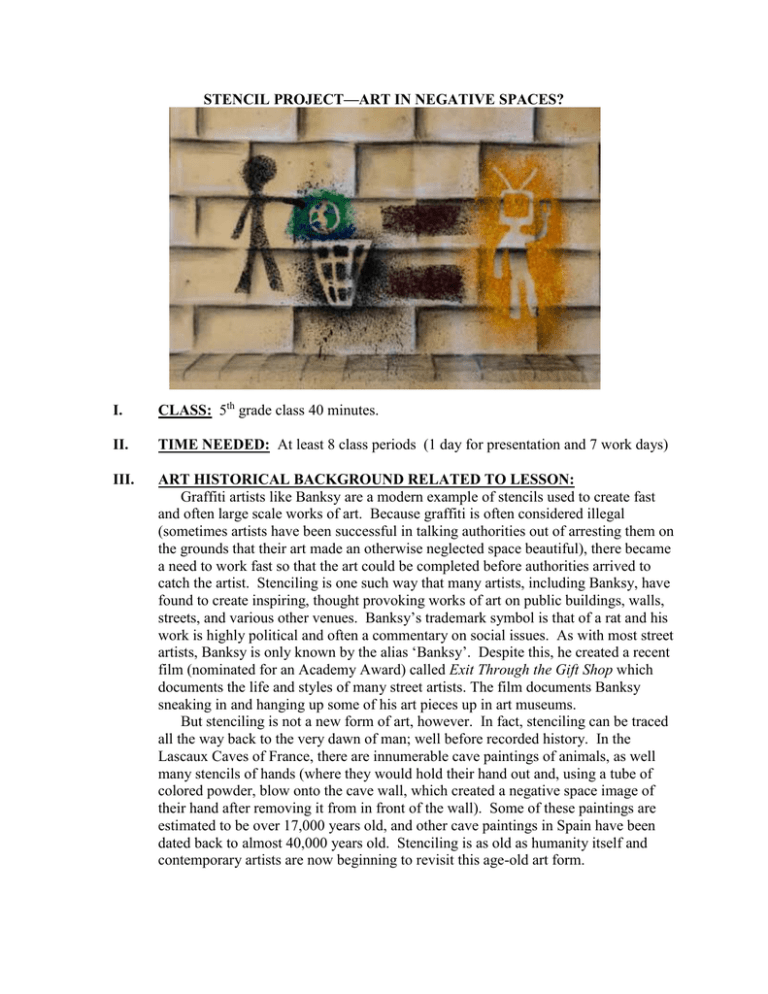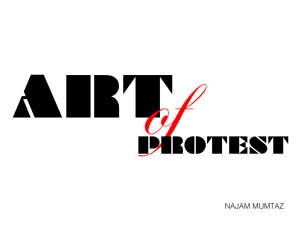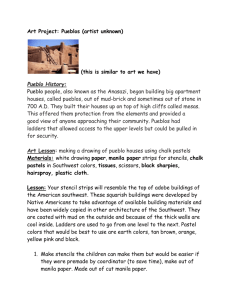File - Casey Becker
advertisement

STENCIL PROJECT—ART IN NEGATIVE SPACES? I. CLASS: 5th grade class 40 minutes. II. TIME NEEDED: At least 8 class periods (1 day for presentation and 7 work days) III. ART HISTORICAL BACKGROUND RELATED TO LESSON: Graffiti artists like Banksy are a modern example of stencils used to create fast and often large scale works of art. Because graffiti is often considered illegal (sometimes artists have been successful in talking authorities out of arresting them on the grounds that their art made an otherwise neglected space beautiful), there became a need to work fast so that the art could be completed before authorities arrived to catch the artist. Stenciling is one such way that many artists, including Banksy, have found to create inspiring, thought provoking works of art on public buildings, walls, streets, and various other venues. Banksy’s trademark symbol is that of a rat and his work is highly political and often a commentary on social issues. As with most street artists, Banksy is only known by the alias ‘Banksy’. Despite this, he created a recent film (nominated for an Academy Award) called Exit Through the Gift Shop which documents the life and styles of many street artists. The film documents Banksy sneaking in and hanging up some of his art pieces up in art museums. But stenciling is not a new form of art, however. In fact, stenciling can be traced all the way back to the very dawn of man; well before recorded history. In the Lascaux Caves of France, there are innumerable cave paintings of animals, as well many stencils of hands (where they would hold their hand out and, using a tube of colored powder, blow onto the cave wall, which created a negative space image of their hand after removing it from in front of the wall). Some of these paintings are estimated to be over 17,000 years old, and other cave paintings in Spain have been dated back to almost 40,000 years old. Stenciling is as old as humanity itself and contemporary artists are now beginning to revisit this age-old art form. IV. SUBJECT: Create a stencil from paper/cardstock to then be used in creating an original, collaborative work of art that represents the kids in their school and community. Each student will stencil on their cut-out to a ‘mural’ size sheet of paper and work collaboratively in executing a successful, cohesive piece. V. EQUIPMENT / AV MATERIALS: PowerPoint presentation, Smart Board projector, computer, TV monitor. VI. SUPPLIES: Pencils, X-Acto knives, scissors, color paper roles, various sizes of paper/construction paper, paint, paintbrushes, spray bottles, chalk, crayons, rulers, and various other objects for tracing shapes i.e. protractor, cans, containers, etc. VII. OBJECTIVES: Academic Skills: The students will learn about famous artists who use stenciling techniques and why the technique is so widely used in publically displayed/street art. Craftsmanship Skills: Students will gain an understanding of how to use scissors as well as tracing and general drawing skills in order to create a successful stencil to be used on a final mural. Cognitive Skills: Think about negative/positive space and how they interact to create forms. Students will also need to think about themselves as part of a larger community and consider what ideas about what that entails (e.g. morality). Social/Behavior Skills: Show respect and patience by working cooperatively together with other students in creating both the stencil cut-out and in deciding placement of stencil on final mural. VIII. BENCHMARKS AND STANDARDS: A. Ohio Benchmarks and Standards in the Visual Arts: 2PE: Identify and communicate how historical and cultural contexts influence ideas that inform artist. 3PR: Experiment with various ideas and visual art media to solve a problem that addresses a contemporary social issue. 5PR: During collaborative art-making experiences, demonstrate respect and support for peer ideas and creativity 4RE: Communicate how personal artistic decisions are influenced by social, environmental and political views. B. Benchmarks and Standards in Other Disciplines: Mathematics: - Measurement: Students will use materials like rulers to measure the size of various objects or body parts. - Geometry and Spatial Sense: Students will need to work cooperatively to harmoniously organize the spacing of their stencils from one another alongside a mural Social Studies: - History: Students will learn in general about the art history street art and especially in its modern form. Science: - Scientific inquiry: Students will use experimentation with materials and think critically about the effectiveness of their implementation before completing mural stencil. English: - Language Acquisition: Students will hear and use vocabulary words including: negative & positive space, aesthetics, stencil, street art, graffiti, calligraphy, outline, X-Acto knife, masking, and silhouette IX. LEARNER OUTCOMES: The student should be able to work cooperatively in order to achieve certain tasks, like having a partner trace their outline on a large piece of paper or working together to figure out an agreed upon composition when they put they stencil their piece onto the mural together. They should be able to use cutting materials i.e. scissors and X-Acto knife, to create a stencil utilizing both positive and negative space. X. SAFETY CONSIDERATIONS: Students need to exercise maturity in working with cutting materials, especially X-Acto knives, as they are very sharp and can easily cause cuts. XI. ALTERNATIVES TO THE LESSON: There are a variety of routes students can take to achieve this task and corresponding levels of difficulty associated with each route. For students who have difficulties, it may be more on their level of do-ability to create a full size stencil of themselves by working with a partner to trace his outline. It won’t be as detailed or complex as perhaps some of other students, but it will still be a successful silhouette with a head, body, arms and legs. Or students can, instead of stenciling themselves, stencil objects or small animals, if they work better on a smaller scale. Students interested in graffiti art, may choose to do a stencil of text. More advanced students can choose to do multiple pieces, a piece with multiple stencils (e.g. throwing objects, speech bubbles, etc.), or just get as intricate with stenciling as they can. XII. THEORY/THEORISTS RELATED TO LESSON: Howard Garner and his Multiple Intelligences theory will come in play big time here by giving students a variety of means to execute a stencil piece—working collaboratively (Interpersonal), working with more hands on techniques (Sensory), and using language i.e. graffiti instead of a physical object (Linguistic). Bronfenbrenner and his Ecological Systems theory is also at play here because the students are prompted to think about themselves in a larger context i.e. in one of Bronfenbrenner’s larger social circles (the Exosystem). XIII. ACADEMIC LANGUAGE: Art vocabulary terms that will be used include: negative & positive space, aesthetics, stencil, street art, graffiti, calligraphy, outline, X-Acto knife, masking, and silhouette. Non-art words and phrases to be aware of include: political/social issues, community, identity, venues, and galleries. XIV. PROCEDURE: 1. Introduction: The first day will begin with a quick pre-assessment of what they know about positive & negative space. This will be followed by a presentation about street art (hopefully starting a discussion about it), including showing a video clip of street artists in action. Then end with review questions and ask about what student think the meaning of some of his pieces are. A. Motivation – Start a class discussion on what is student’s think ‘art’ is. Questions to prompt students include: “Is it only art if it hangs in a gallery?”, “Is graffiti ‘art’?”, “Should street art/graffiti be illegal?” Show images of Banksy and other street artists. Then show a video clip of Banksy’s film Exit Through the Gift Shop to see real life street artists in action. End with some questions and a discussion about the meaning behind some of Banksy’s work they saw. B. New and Reviewed Experiences – Students should have previous experience with the concepts of value and shading in order to create a background piece (e.g. a brick wall) for their stencil to be applied onto. Students who choose to do text for their stencil, will also have prior experience in using text in creating art from their radial name/initials project. New experiences might be using toothbrushes and paintbrushes for splatter painting. 2. Distribution of Materials/Implements: Helpers will be chosen to pass out supplies. 3. Work Period: Day 1: Students will begin by sketching out ideas for their stencil—basic drawings showing that they considered at least a couple different options for what kind of stencil to create. Day 2: Do a small practice stencil onto a background sheet of paper to give them practice with splatter painting. Day 3: Create a background drawing on which their stencil with be applied (e.g. a brick wall) Day 4: Begin to draw and cut out their final stencil. Work on incorporating both positive and negative spaced with the stencil. Day 5-6: Begin to apply their stencils onto the final background paper. 4. Clean Up: Each student is e responsible for cleaning their area and returning supplies 5. Teacher-pupil Appraisal of the Art Activity: During each class activity I will be walking around to check if each student is making progress, and at the end of each session a quick formative assessment will be applied by asking review questions about art vocabulary terms, artists, and concepts. XV. EVALUATION OF STUDENT WORK: During each session I will do formative assessments by walking around and giving feedback/help to students as they work. At the end of each session, review questions will be asked regarding various terms, concepts, and artists that we discuss. At the end of the project student will be graded on whether they were able to use their time effectively and wisely to create a background drawing, a stencil with both positive and negative elements, an overall piece with some personal or social message/meaning, and whether they demonstrating quality craftsmanship in creation of artwork. Assessment of student ability to complete art activity Criteria 1 – Creates a quality background drawing onto which stencil will be applied Criteria 2 – Creates a quality stencil that utilizes both positive and negative spaces Criteria 3 – Creates an artwork with a personal/social meaning Criteria 4 – Effort: took time to develop idea & complete project. (Didn’t rush.) Good use of class time Criteria 5 – Craftsmanship – Neat, clean & complete. Skillful use of the art tools & media. Total: 50 X 2 = 100 (possible points) Possible points: 100 Excellent Good Average 10 9–8 7 Needs improvement 6 or less 10 9–8 7 6 or less 10 9–8 7 6 or less 10 9–8 7 6 or less 10 9–8 7 6 or less 100 – 91 points = A 90 - 80 points = B 69 – 60 points = D 59 – 0 points = F 79 – 70 points = C




